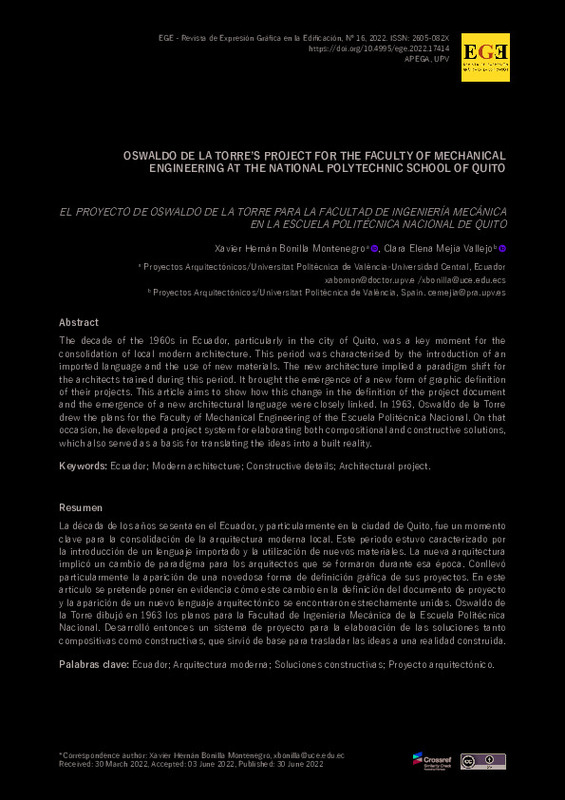JavaScript is disabled for your browser. Some features of this site may not work without it.
Buscar en RiuNet
Listar
Mi cuenta
Estadísticas
Ayuda RiuNet
Admin. UPV
Oswaldo de la Torre's project for the Faculty of Mechanical Engineering at the National Polytechnic School of Quito
Mostrar el registro sencillo del ítem
Ficheros en el ítem
| dc.contributor.author | Bonilla Montenegro, Xavier Hernán
|
es_ES |
| dc.contributor.author | Mejía Vallejo, Clara Elena
|
es_ES |
| dc.coverage.spatial | east=-78.18340599999999; north=-1.831239; name=Ecuador | es_ES |
| dc.date.accessioned | 2022-07-07T07:35:42Z | |
| dc.date.available | 2022-07-07T07:35:42Z | |
| dc.date.issued | 2022-06-30 | |
| dc.identifier.issn | 1888-8143 | |
| dc.identifier.uri | http://hdl.handle.net/10251/183909 | |
| dc.description.abstract | [EN] The decade of the 1960s in Ecuador, and particularly in the city of Quito, was a key moment for the consolidation of local modern architecture. This period was characterised by the introduction of an imported language and the use of new materials. The new architecture implied a paradigm shift for the architects who were trained during this period. It brought with it the emergence of a new form of graphic definition of their projects. This article aims to show how this change in the definition of the project document and the emergence of a new architectural language were closely linked. In 1963, Oswaldo de la Torre drew the plans for the Faculty of Mechanical Engineering of the Escuela Politécnica Nacional. On that occasion he developed a project system for the elaboration of both compositional and constructive solutions, which served also as a basis for translating the ideas into a built reality. | es_ES |
| dc.description.abstract | [ES] La década de los años sesenta en el Ecuador, y particularmente en la ciudad de Quito, fue un momento clave para la consolidación de la arquitectura moderna local. Este periodo estuvo caracterizado por la introducción de un lenguaje importado y la utilización de nuevos materiales. La nueva arquitectura implicó un cambio de paradigma para los arquitectos que se formaron durante esa época. Conllevó particularmente la aparición de una novedosa forma de definición gráfica de sus proyectos. En este artículo se pretende poner en evidencia cómo este cambio en la definición del documento de proyecto y la aparición de un nuevo lenguaje arquitectónico se encontraron estrechamente unidas. Oswaldo de la Torre dibujó en 1963 los planos para la Facultad de Ingeniería Mecánica de la Escuela Politécnica Nacional. Desarrolló entonces un sistema de proyecto para la elaboración de las soluciones tanto compositivas como constructivas, que sirvió de base para trasladar las ideas a una realidad construida. | es_ES |
| dc.language | Inglés | es_ES |
| dc.language | Español | |
| dc.publisher | Universitat Politècnica de València | es_ES |
| dc.relation.ispartof | EGE Revista de Expresión Gráfica en la Edificación | es_ES |
| dc.rights | Reconocimiento (by) | es_ES |
| dc.subject | Ecuador | es_ES |
| dc.subject | Modern architecture | es_ES |
| dc.subject | Constructive details | es_ES |
| dc.subject | Architectural project | es_ES |
| dc.subject | Arquitectura moderna | es_ES |
| dc.subject | Soluciones constructivas | es_ES |
| dc.subject | Proyecto arquitectónico | es_ES |
| dc.title | Oswaldo de la Torre's project for the Faculty of Mechanical Engineering at the National Polytechnic School of Quito | es_ES |
| dc.title.alternative | El proyecto de Oswaldo de la Torre para la Facultad de Ingeniería Mecánica en la Escuela Politécnica Nacional de Quito | es_ES |
| dc.type | Artículo | es_ES |
| dc.identifier.doi | 10.4995/ege.2022.17414 | |
| dc.rights.accessRights | Abierto | es_ES |
| dc.contributor.affiliation | Universitat Politècnica de València. Departamento de Proyectos Arquitectónicos - Departament de Projectes Arquitectònics | es_ES |
| dc.contributor.affiliation | Universitat Politècnica de València. Escuela Técnica Superior de Arquitectura - Escola Tècnica Superior d'Arquitectura | es_ES |
| dc.description.bibliographicCitation | Bonilla Montenegro, XH.; Mejía Vallejo, CE. (2022). Oswaldo de la Torre's project for the Faculty of Mechanical Engineering at the National Polytechnic School of Quito. EGE Revista de Expresión Gráfica en la Edificación. (16):27-49. https://doi.org/10.4995/ege.2022.17414 | es_ES |
| dc.description.accrualMethod | OJS | es_ES |
| dc.relation.publisherversion | https://doi.org/10.4995/ege.2022.17414 | es_ES |
| dc.description.upvformatpinicio | 27 | es_ES |
| dc.description.upvformatpfin | 49 | es_ES |
| dc.type.version | info:eu-repo/semantics/publishedVersion | es_ES |
| dc.description.issue | 16 | es_ES |
| dc.identifier.eissn | 2605-082X | |
| dc.relation.pasarela | OJS\17414 | es_ES |
| dc.description.references | Bonilla, X., Villagómez, J. 2018. Interview with Fausto Moreno Ormaza [Personal communication]. | es_ES |
| dc.description.references | Frampton, K. 1999. Studies in Tectonic Culture. AKAL Editions. | es_ES |
| dc.description.references | Hermida, M.A., Guerra, J. 2010. Perspectives on Modern Architecture in Ecuador Volume II. In Miradas a la Arquitectura Moderna en el Ecuador Tomo II: Vol. II (pp. 44-47). | es_ES |
| dc.description.references | Kraemer, S. 2011a. Interviews and houses. In Casas y arquitectos modernos en Quito. A referential generation (pp. 90-102). Universidad San Francisco de Quito - USFQ. | es_ES |
| dc.description.references | Kraemer, S. 2011b. Interviews and houses. In Casas y arquitectos modernos en Quito. A referential generation (p. 93). Universidad San Francisco de Quito - USFQ. | es_ES |
| dc.description.references | Sánchez, J.H. 2008. Interview with Oswaldo de la Torre Villacreses [Audio]. | es_ES |
| dc.description.references | Vanegas, C. 2020, July 10. Interview with Cristina Vanegas (X. Bonilla & Villagómez Juan) [Audio visual]. | es_ES |








